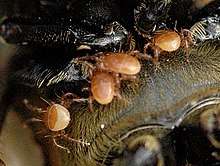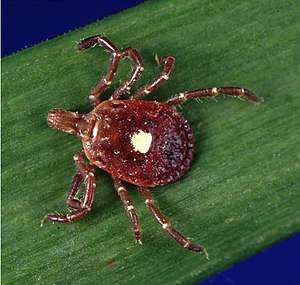Parasitidae
Parasitidae is a family of predatory mites in the order Mesostigmata that has worldwide distribution.[1] They are the only family in the superfamily Parasitoidea. Relatively large for mites, their color is often yellowish to dark brown. The family as a whole preys on a wide variety of microarthropods and nematodes, with individual species usually having a narrower range of prey. The family contains two subfamilies, 29 genera, and around 400 species.[1][2]
| Parasitidae | |
|---|---|
 | |
| Poecilochirus carabi | |
| Scientific classification | |
| Kingdom: | |
| Phylum: | |
| Class: | |
| Subclass: | |
| Order: | |
| Suborder: | Parasitina |
| Superfamily: | Parasitoidea Oudemans, 1901 |
| Family: | Parasitidae Oudemans, 1901 |
| Subfamilies | |
| |
The subfamily Pergamasinae is normally found in the soil, and dispersal via phoresy is not known in this subfamily. It contains 9 genera. Most species are bisexual.[1][2][3]
The subfamily Parasitinae is normally found in nests of small animals or insects or in decaying organic matter, from seaweed to forest litter. This subfamily contains 20 genera. These mites disperse via phoresy in the deuteronymph stage of their life cycle. The genus Parasitellus is associated with bumblebees, and other genus with other bees, leading to the common name "bee mites". Other genus disperse on various beetles, leading to the name "beetle mites" which is also shared with the order of mites Oribatida, who have the name for a different reason.[1][2][4]
Taxonomy
Parasitidae contains three taxonomic groups – two subfamilies and a group of genera not yet placed:[5]
|
Subfamily Parasitinae Oudemans, 1901
Subfamily Pergamasinae Juvara-Bals, 1976
|
Incertae sedis
|
External links
References
- B. OConner & Pavel B. Klmiov (April 3, 2004). "Bee Mites : Acari : Parasitiformes". Division of Insects, University of Michigan Museum of Zoology. Archived from the original on December 12, 2012. Retrieved July 23, 2009.
- Zhi-Quiang Zhang (August 2003). "Other Beneficial Mites". Mites of greenhouses. Wallingford, Oxon ; Cambridge, MA: CAB International. pp. 211–212. ISBN 978-0-85199-590-8. Retrieved July 23, 2009.
- David Evans Walter (September 15, 2006). "Pergamasinae". Lucid Keys. Retrieved July 24, 2009.
- Nathan Banks (April 10, 1915). The Acarina or Mites. A Review of the Group for the Use of Economic Entomologists. Report No. 108. Washington, D.C.: United States Department of Agriculture. Retrieved July 23, 2009.
- Joel Hallan (ed.). "Parasitidae Species Listing". Biology Catalog. Texas A&M University. Retrieved September 4, 2010.
